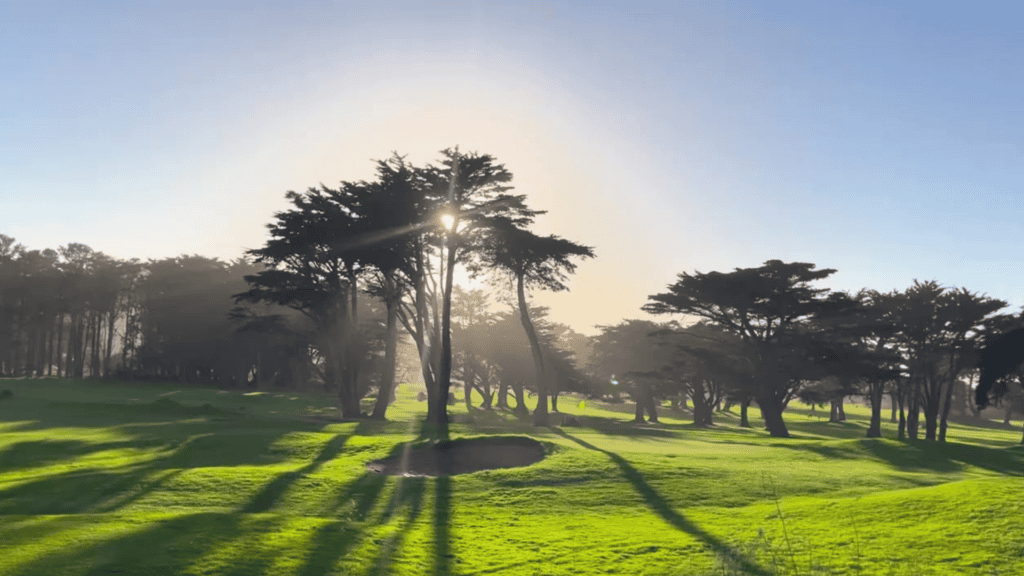Origins and Early History of Sharp Park Golf Course
Sharp Park Golf Course, located in Pacifica, California, is a testament to a rich history that dates back to the mid-19th century. The land on which the golf course now sits was originally the estate of George F. Sharp. Sharp established the over 400-acre estate in 1849. He was prominent figure of his time, deeply connected to the land and its development. He envisioned it as a place of both beauty and utility.
When George Sharp passed away in October 1882, his legacy was carried forward by his wife, Honora Sharp. Honora continued to manage the estate with a vision of its potential for public enjoyment. Upon her death on February 8, 1905, Honora Sharp bequeathed the estate to the City of San Francisco. She gave explicit instructions that the property be used for recreational purposes. If the property was ever designated anything else it would revert to the ownership of their heirs. This generous donation laid the foundation for what would become one of the region’s most beloved public recreational areas.

Development of Sharp Park Golf Course
The early 20th century saw the City of San Francisco seeking to fulfill Honora Sharp’s vision for the estate. John McLaren, a key figure in San Francisco’s urban planning and the superintendent of Golden Gate Park, saw the potential for creating a premier public golf course. In 1930, McLaren enlisted the help of Dr. Alister MacKenzie. MacKenzie was one of the most renowned golf course architects of the time, to design Sharp Park Golf Course.
Dr. MacKenzie, famous for his work on Augusta National in Georgia and Cypress Point in Pebble Beach, brought his expertise and innovative design principles to Sharp Park. He aimed to create a course that blended seamlessly with the natural landscape. While offering a challenging yet accessible experience for golfers. MacKenzie’s design utilized the diverse topography of the area, including its coastal dunes, wetlands, and rolling hills. The course officially opened in 1932. It marked the beginning of a new chapter in the estate’s history as a public recreational space.
Architectural Significance
Sharp Park Golf Course is celebrated for its classical design elements that are characteristic of MacKenzie’s work. His philosophy of integrating natural features into the course layout is evident in the strategic placement of bunkers, the natural contours of the greens, and the incorporation of existing water features. MacKenzie’s design ensures that the course is not only a challenge to play but also a visual delight.
One of the standout features of Sharp Park is its bunkering. MacKenzie’s bunkers at Sharp Park are large, deep, and irregularly shaped, strategically placed to challenge golfers and add to the course’s aesthetic appeal. The greens, known for their subtle undulations and varying sizes, require precision and careful reading, further enhancing the strategic element of the game.
Environmental and Historical Challenges
Over the years, Sharp Park has faced numerous challenges, particularly related to its environmental impact and the need for preservation. The course is home to the endangered San Francisco garter snake and the California red-legged frog. The presence of these species has led to significant conservation efforts and sparked debates about the course’s future.
In the early 2000s, environmental groups raised concerns about the impact of the golf course on these endangered species. Proposals to close or alter the course to protect the wildlife were met with strong opposition from the golfing community and local residents, who valued Sharp Park as a historic and recreational treasure. This conflict led to a series of legal and political maneuvers aimed at finding a compromise that would protect both the wildlife and the golf course.
In 2011, the San Francisco Board of Supervisors approved a plan to maintain the golf course while implementing measures to protect the endangered species. This plan included habitat restoration projects, modifications to the course layout to reduce environmental impact, and ongoing monitoring of wildlife populations. The efforts to balance recreational use with environmental stewardship continue to shape the management of Sharp Park.
Cultural and Recreational Importance of Sharp Park Golf Course
Despite these challenges, Sharp Park Golf Course remains a beloved institution in the Bay Area. It has hosted numerous local tournaments and events, serving as a vital recreational space for the community. The course’s affordability and public accessibility ensure that it remains a popular destination for golfers of all skill levels.
The cultural significance of Sharp Park extends beyond its recreational value. It represents a link to the golden era of golf course design and stands as a living testament to MacKenzie’s architectural legacy. Efforts to preserve and restore the course have focused not only on environmental concerns but also on maintaining its historical integrity. Restoration projects aim to return the course to its original design as closely as possible, ensuring that future generations can experience MacKenzie’s vision.
Historical Footnote
In addition to the golf course itself, there was a notable historical footnote regarding George F. Sharp’s legacy. Mrs. Sharp paid for an honorary statue in Golden Gate Park to commemorate her husband’s contributions. However, these plans were never realized, and no statue was erected. Golden Gate Park, established in the late 19th century, is home to many commemorative monuments and has played a crucial role in the city’s cultural and recreational life, but Sharp’s recognition within this space remains absent.
Conclusion
Sharp Park Golf Course’s history is a rich tapestry of visionary design, environmental challenges, and cultural significance. From its inception in the 1930s as a collaboration between John McLaren and Dr. Alister MacKenzie, the course has grown into a cherished public golfing venue, celebrated for its natural beauty and strategic design. The ongoing efforts to balance historical preservation with environmental conservation underscore the complexity and importance of maintaining such a multifaceted landmark.
As Sharp Park Golf Course continues to evolve, it remains a symbol of the enduring legacy of classical golf course architecture and the community’s commitment to preserving its recreational and natural heritage. Whether viewed through the lens of its historical significance, environmental impact, or cultural value, Sharp Park Golf Course stands as a remarkable chapter in the story of Pacifica, California, and the world of golf.
Sharp Park Golf Course
1 Sharp Park Road
Pacifica CA 94044
650-359-3380
